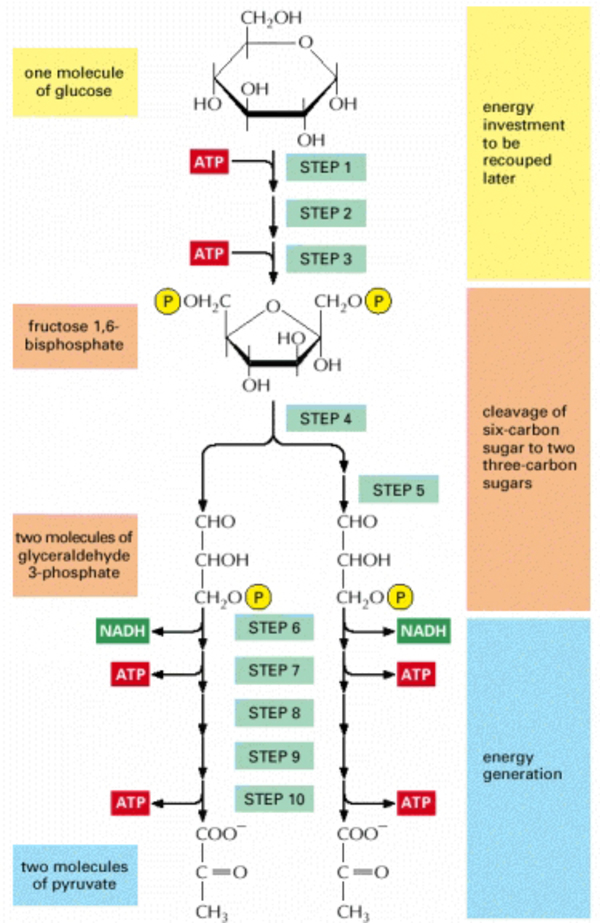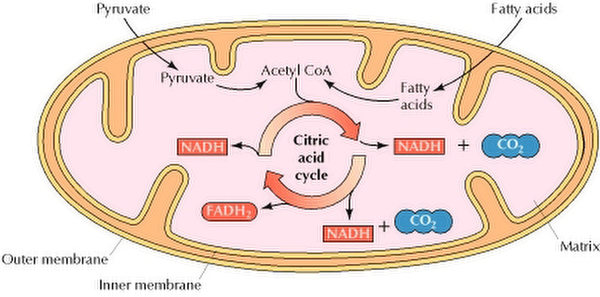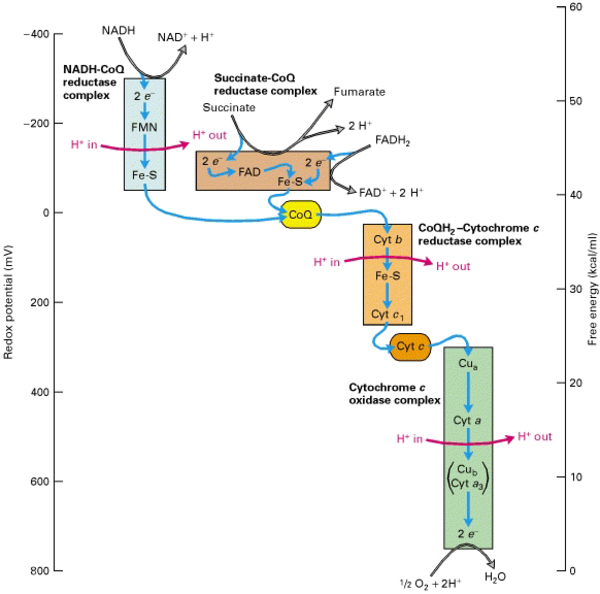Cellular Respiration
What Are the Steps Involved in Cellular Respiration?
Teacher Note: Connection
In this concept, students describe changes of energy and matter in living things in terms of energy and matter flowing into, out of, and within their systems through the process of cellular respiration. They learn that the total amount of energy is conserved during cellular respiration because energy is transformed, not gained or lost.
As students read and comprehend complex texts, view the videos, and complete the interactives, labs, and other Hands-On Activities, have them summarize and obtain scientific and technical information. Students will use this evidence to support their initial ideas about how to answer the Explain Question or their own question they generated during Engage. Have students record their evidence using My Notebook.
Cellular Respiration
The process of releasing energy from food is called cellular respirationglossary term (opens in a new window). When discussing cellular respiration, the term does not refer to breathing. Cellular respiration is different from breathing. It is a process that takes place inside cells. Cellular respiration involves many chemical reactions within each individual cell.
Teacher Note: Misconception
Students may think that respiration only refers to breathing. In fact, cellular respiration involves a series of chemical reactions that take place inside cells and yield usable energy from complex organic molecules.
Reactants and Products
Animals and numerous microorganisms get their nutrition from organic matter that they metabolize in the presence of oxygen to obtain energy and building blocks to grow, reproduce, and survive. They rely on a type of metabolism called aerobic cellular respiration. For organisms that live by aerobic respirationglossary term (opens in a new window) of organic carbon sources, their primary source of food originates with carbohydrate-rich plants (or other organisms that eat carbohydrate-rich plants) whose mass and stored chemical energy was made during photosynthesis.
One of the simplest and most common sugar molecules used for energy is glucose, a direct product of photosynthesis. Organisms that get their nutrition from plants then use cellular respiration to metabolize, or break down, a glucose molecule into smaller molecules. Energy is released during this process and is used to make ATP. The process takes place through a series of chemical reactions.
In the case of cellular respiration, the primary reactants are glucose (or sometimes fatty or amino acids) and oxygen. Both glucose and oxygen are products of photosynthesis. When glucose is respired in the presence of oxygen, energy is released and carbon dioxide and water are produced. The basic chemical reaction for cellular respiration is shown here:
C6H12O6+ 6O2 → 6CO2 + 6H2O + Energy (ATP)
or
Glucose + Oxygen → Carbon Dioxide + Water + Energy (ATP)
This reaction is exothermic. The steps of cellular respiration include a series of oxidationglossary term (opens in a new window)-reduction reactions, or redox reactions. During these reactions, one substance gains an electron and is reduced, while another substance loses an electron and is oxidized. The substance that donates an electron is called the reducing agentglossary term (opens in a new window). The substance receiving an electron is called the oxidizing agentglossary term (opens in a new window). In summary, during a redox reaction, a reducing agent becomes oxidized and an oxidizing agent becomes reduced.
Redox reactions release energy because electrons move from a high-energy state to a low-energy state. Energy is given off in the process. This energy can be used to make high-energy compounds such as ATP. During cellular respiration, oxygen becomes reduced, forming water. Sugars become oxidized, forming carbon dioxide. The process takes place in three stages.
Glycolysisglossary term (opens in a new window) is the first stage of respiration. Glycolysis occurs in the cytoplasm of the cell. In eukaryotic cells such as animal cells, the products from glycolysis move into mitochondria. The second stage of cellular respiration, the Krebs cycle, takes place in the matrix of the mitochondria. Finally, the third stage takes place along the inner membrane of the mitochondria. This third and final stage is called the electron transport chainglossary term (opens in a new window). In prokaryotic cells such as bacteria, glycolysis and the Krebs cycle take place in the cytoplasm, but the final stage of electron transport takes place along the plasma membrane.
For every molecule of glucose produced by photosynthesis and then oxidized by aerobic respiration, up to 38 molecules of ATP can be produced. However, the yield is more commonly around 30 ATPs. The oxygen and sugars derived from photosynthesis are respired into carbon dioxide and water. The same carbon dioxide and water can be used by photosynthetic plants, with the help of sunlight for energy, to make sugar and oxygen. The two processes are interdependent for the cycle of life to continue.
Teacher Note: Practices
In this exploration, students will use a model experimental set-up to generate data to support the explanation of the conversion of oxygen to carbon dioxide during cellular respiration. After students have completed the exploration, expand on student understanding by leading a class discussion regarding why physical exercise results in heavier breathing.
Glycolysis
The first stage of cellular respiration is glycolysis. Glycolysis is a form of anaerobic respirationglossary term (opens in a new window) that consists of ten stepwise chemical reactions. During these steps, a six-carbon glucose molecule, C6H12O6, is broken down into two three-carbon molecules called pyruvate. A different enzyme is required for each of these reactions.
During the first few steps of glycolysis, two molecules of ATP are required. An ATP molecule loses one phosphate, becoming adenosine diphosphate, or ADP. When the bond between the second and third phosphate is broken, energy is released, helping the steps of glycolysis continue forward. Although the main purpose of cellular respiration is to release energy, some energy is required for the process to take place. Two ATP molecules are a small investment for the large amount of ATP that will be produced by the end of the process.
During the latter reactions of glycolysis, enough energy is released to produce four molecules of ATP. This means that the entire process of glycolysis involves a net production of two ATP molecules. Additionally, two more high-energy molecules called NADH are produced. NAD stands for nicotinamide adenine dinucleotide. The extra H on the end means “plus hydrogen,” which refers to the reduced version of NAD.
In summary, the ten reactions of glycolysis require glucose and two ATP molecules for energy. The outcome includes four ATP molecules, two NADH molecules, and two molecules of pyruvate. The pyruvate molecules will continue to be broken down as cellular respiration continues to the next stage.
The Krebs Cycle
Following glycolysis, the pyruvate molecules are transported across each of two lipid bilayers of mitochondria. They enter the inner mitochondrial matrix. Each molecule is then converted to another molecule called acetyl coenzyme A, or acetyl CoA. This is the starting molecule for the next stage of cellular respiration. In the first step of the Krebs cycle, acetyl CoA donates its two-carbon acetyl group to another molecule. The resulting molecule is called citrate. Citrate is then modified in each of the next steps of the Krebs cycle. By the end of the cycle, the original molecule that reacted with acetyl CoA is actually regenerated. This allows the cycle to begin again and continue with each new molecule of acetyl CoA.
There is a total of eight reactions in the Krebs cycle. Like glycolysis, each reaction requires a unique enzyme. Three molecules of NADH, one molecule of ATP (or GTP), and a molecule of FADH2 are all produced. FADH2 is another high-energy molecule and stands for flavin adenine dinucleotide. Again, the H2 indicates a reduced version of the FAD molecule.
Remember that there are two pyruvate, and thus two acetyl CoA, molecules resulting from a single glucose molecule. This means that for each glucose molecule, two full turns of the Krebs cycle occur. Therefore, the energy-containing products from the Krebs cycle are 6 NADH, 2 ATP, and 2 FADH2.
The Electron Transport Chain
By the end of glycolysis and the Krebs cycle, a molecule of glucose has produced a net of only four ATP molecules. It is during the next and final stage of cellular respiration that most ATP production occurs. During the electron transport chain, the other high-energy molecules NADH and FADH2 go to work.
The electron transport chain is a series of protein complexes. It is embedded in the inner mitochondrial membrane. These complexes are “electron carriers.” NADH and FADH2 donate electrons to the first complex in the series. Electrons are passed down the chain, from one protein complex to the next. Each subsequent protein complex donates the electrons to its neighbor, one by one, and energy is released at each step. These transmembrane protein complexes also include ion pumps. The energy that is released in each electron-passing step is used to pump H+ ions across the membrane. The H+ ions are released from NADH and FADH2 at the same time that they donate their electrons. As these free H+ ions accumulate in the mitochondrial matrix, the ion pumps in the chain pump them from the matrix into the intermembrane space.
Two important final steps occur in the electron transport chain. One might wonder what happens to the donated electrons once they reach the final protein complex of the chain. This is when the critical oxygen molecule becomes a factor. Oxygen serves as the final electron acceptor. When an O2 molecule accepts electrons, it becomes negatively charged. It then picks up free-floating H+ ions, forming two molecules of H2O.
Finally, the main question remains: How is ATP produced by the electron transport chain? The answer involves another very special transmembrane H+ protein channel. In the final step, the large numbers of H+ ions that have been pumped into the intermembrane space now form a concentration gradient between the intermembrane space and the matrix. This concentration gradient causes them to flow back into the matrix through a channel called ATP synthase. The H+ ions passing through this channel cause a rotor within the channel to spin. This spinning rotor creates the energy needed to synthesize large amounts of ATP from ADP. This spinning force is only possible due to the large H+ concentration gradient between the intermembrane space and the mitochondrial matrix.
Approximately 32-34 molecules of ATP are produced during the electron transport chain. A net total of 36-38 molecules of ATP can be produced from a single molecule of glucose. However, in reality, because of various losses in the process, around 30 are usually made.
Teacher Note: Connections
Students will analyze the system of chemical reactions that constitute cellular respiration, defining the initial conditions and boundaries of the organelles involved in the process and the inputs and outputs (reactants and products) of each stage. After students complete this item, they can create diagrams of a cell to model the steps of cellular respiration, writing the reactants and products of each stage on the structures of the cell in which they take place.



